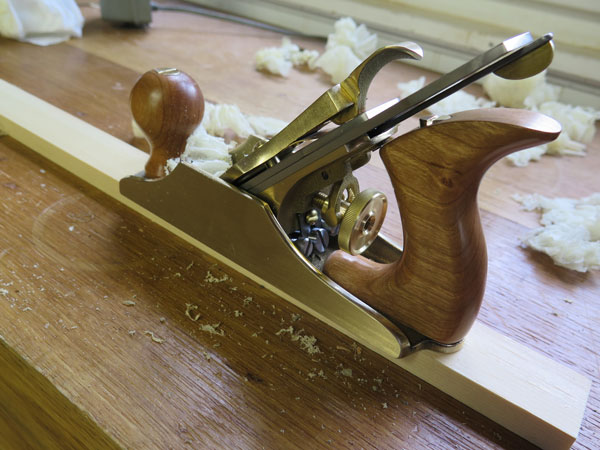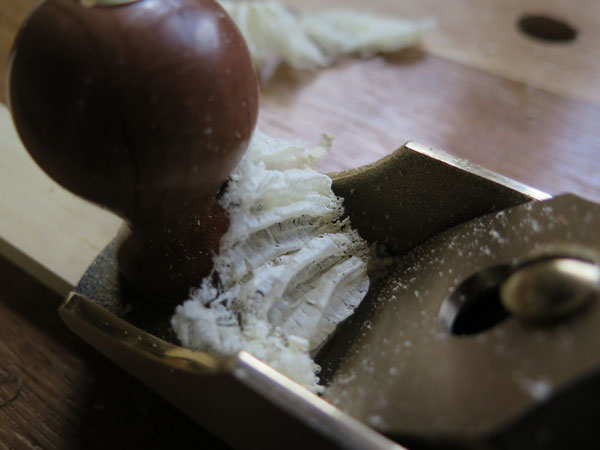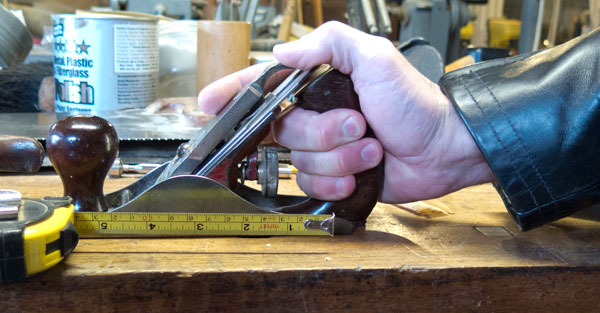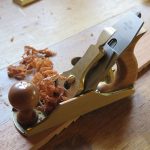We may receive a commission when you use our affiliate links. However, this does not impact our recommendations.
I’m the weirdo who counts the number of steps and hand motions it takes me to brew a cup of coffee. And I’m always looking for ways to shave away a few minutes here and there from my routine activities (for example, brushing my teeth while simultaneously fetching my clothes for the day).
So it’s no surprise that I also do this in the shop. During the last couple years I’ve noticed how much I use my block plane for smoothing large panels. Its small sole helps me get into the hollows on tabletops and case sides, shaving off lots of time to get a finished panel.
The only problem with using a block plane as a smoothing plane is you don’t have a cap iron (a handy thing to have when you face nasty grain), and getting the iron curved just right for the tool’s low bed is more difficult than it is on a traditional bench plane.
So last week I decided to switch to a No. 2 bench plane for a year and put my No. 4 on the shelf. So I purchased (at full retail) a bronze Lie-Nielsen No. 2.
The No. 2 is just a wee bit longer (7-1/2”) than my block plane (6-1/4”). And its blade is 1-5/8” wide, which is just 1/4” wider than my block plane’s. And the No. 2 has a few things my block plane doesn’t, including a cap iron, a lateral-adjust lever and a blade adjustment wheel that is easier to reach while my hands are pushing the tool.
When I mentioned this experiment to a few friends, they said I was going to hate the tool’s tote – I’d never get my fingers between the tote and the frog. And while it’s true I can’t use a four-fingered grip on the tote, I’m not worried for two reasons:
- If you hold the tool like a coffin smoothing plane it feels just like you are holding a wooden coffin smoothing plane. In other words, you wrap your hand around the tote and frog.
- My friend Carl Bilderback showed me a way to alter the tote so I could use it with a traditional grip. To demonstrate, he showed me his Millers Falls plane in the No. 2 size. My hand went right in. So I’m going to make a replacement tote for this Lie-Nielsen No. 2 using measurements from the Millers Falls tote.
This afternoon I set up the No. 2 by sharpening the iron and tuning up the cap iron so it could be used for the most difficult woods. Tomorrow I’ll post a video that shows how I go about tuning and setting the cap iron – I’ll also show the grip I’m using on the tool right now.
And then Wednesday I’ll show how smoothing planes have been increasing in size since the 17th century, and have perhaps become too bloated. So stay tuned.
— Christopher Schwarz
P.S. If you’d like to fix up a vintage plane, check out my DVD “Super-tune a Handplane,” which is available from ShopWoodworking.com.
Here are some supplies and tools we find essential in our everyday work around the shop. We may receive a commission from sales referred by our links; however, we have carefully selected these products for their usefulness and quality.












Chris,
Can I get a Super Tune a Handplane in book form?
I use the Veritas Bevel Up block plane with the large tote and front knob. Works like a charm! I use the high angle iron when planing gnarly wood.
Chris,
I sure wish L-N made the #2 with a choice of frogs as they offer for their larger bench planes. Or at least with a 50 or 52 degree frog instead of just a 45. I suggested this to them but I bet you would have more influence, Chris, haha!
Rob
“If you hold the tool like a coffin smoothing plane it feels just like you are holding a wooden coffin smoothing plane. In other words, you wrap your hand around the tote and frog.”
Chris, I’m just curious–if you want a plane that feels like a coffin smoother, why not use a coffin smoother?
Isn’t a No 1 even closer to your block plane? I’m curious to know if you considered the 1 vs 2 and if so, why did the No 2 win out.
I remember during the Dutch Toolchest build (California) that you only had your block plane and were using it most effectively for all your planing tasks.
I am building a work bench, on the model of the Shaker bench in your workbench design book. I’m a lefty so the end vise will go to the left and am thinking of substituting an old leg vice I have for the front vice on the right leg. I plan to build the legs in plane with the front of the top. I’ll set the cabinet (and drawers) back a bit to avoid interference with any work pieces which might be supported by dogs in the left front leg. Is there any reason the right set of legs can’t or shouldn’t be built flush with the right end of the table instead of insetting them the 13″ or so from the end of the top as designed (which would accommodate additional cabinet space)?
I started with a #3 and it is still my all-time favorite size to use. I keep two #603’s in tune for rough and finish work. My second is a #5-1/4. Go figure.
This is an interesting idea. It would be great if you could give updates every few months to let us know how its working out. I. Have been reluctant to buy a No. 4 when I am happy with using a No. 5 for 70% of my smoothing operations. I have experimented with using a block plane and was just moderately satisfied with it.
Chris, that’s why I enjoy my LA Block Plane with the added knob & tote from LV. True, not as wide as a #2, but the tote makes it more usable.
Hey Chris, that #2 will grow on you, I bet. I have a Bedrock 603 that I was using as my smoother before I got the LN #4 about 7 years ago. I still use it. It’s great to have the option for even more reasons than you mentioned. Every project has different needs and my 603 comes in handy on almost every one.
I know your smoother has the high angle frog making it harder to push so it’ll be interesting to see if that aspect is noticed in the transition.
BTW…..why put the #4 on the shelf for a year?? Can’t see the logic in that.
Don
I hope you told Lie-Nielsen that you were going to post this article. Their website will probably crash under the strain of all the Groupies clambering to purchase a #2.
Tongue in cheek comment aside, it will be interesting to see if you still prefer this to the block plane after a good couple of months.